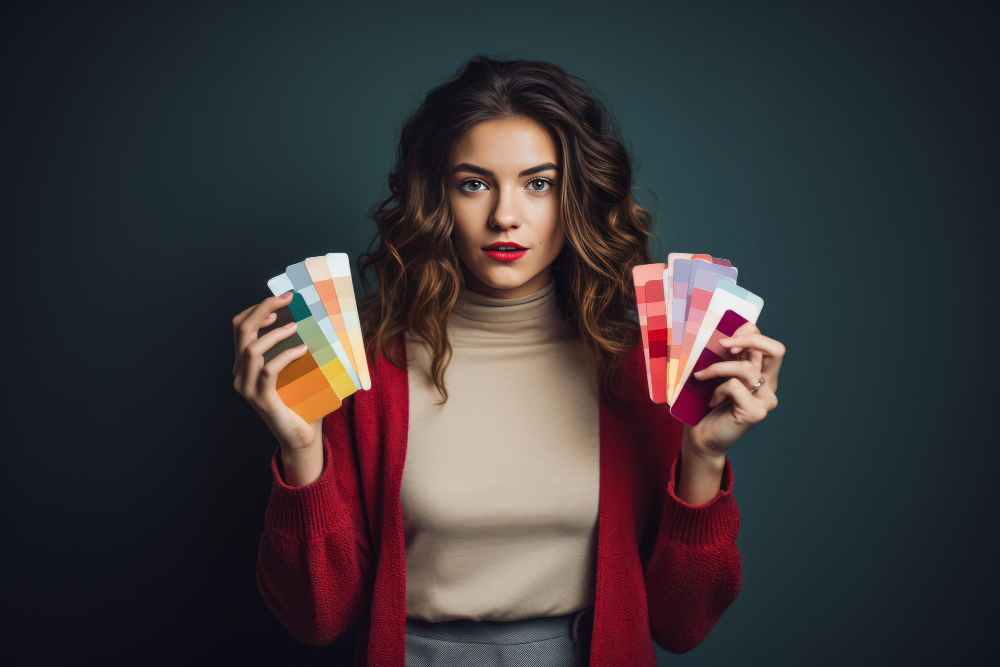
Colors are convenient ways to convey important information. Their strong and immediate impact makes them crucial to branding efforts.
Utilizing brand colors consistently across all platforms can create a unified look and feel for your company. It helps to make the company memorable and easily recognizable. Brand colors can also impact customers’ behavior and experience, making them practical tools for branding.
You can choose the brand colors based on the brand’s tone, industry, value, equity, targeted audience, and competition.
In this blog, we will help you choose brand colors and understand how many colors are adequate for a brand.
What are Brand Colors? Choosing Brand Colors

Brand colors represent the brand. That’s why it has been advised to choose two to four primary colors and combine them with as many accent colors as you like.
People often ask how many colors are essential for a brand. The brand color palette should have five to ten different colors used simultaneously to represent a brand.
Strategic use of colors can generate significant results in boosting a brand’s visibility and recognition.
Brand colors are widely used in logo design, the company’s website, social media, business cards, presentations, prints, and brochures. Service-based industries also use brand colors in uniforms.
Brand color can play an evident function in customer decision-making. It has been noted that customers subconsciously rely on the product’s color before exploring the product or the brand.
Choosing the colors is more than finding a shade of blue you like. It extends beyond simply opting for visually attractive or harmonious colors. It involves choosing colors that genuinely contemplate your company’s identity.
In short, choosing a color palette for branding becomes easy when you have a rich understanding of the brand’s identity, values, customers, competition, and position.
Guide on Choosing Brand Colors

Choosing the brand color is a significant decision, and you may be curious about how to select branding colors for your business. This section will give you complete guidelines for choosing the brand colors.
Establish Brand Identity

Establishing your brand identity will help you understand the motive, objective, and thought behind the brand. The brand identity is the visual personality of the brand. By understanding how you want the audience to perceive your brand, you can understand the role and significance of different colors to promote those messages.
The colors represent the brand identity; hence, they should comply with the brand’s values, messages, and story. So, you need to uncover the brand identity to know the right colors.
This small activity can help you quickly find the colors you want for your brand. Compose a list of adjectives representing the company personality and character you want to use for your brand.
The spectrum of brand identity traits is critical for building a brand and can help you determine your brand’s core. Then, explore which color is used to show which adjective and comply with it in your brand colors.
Explore Color Meaning

As mentioned above, different colors have different meanings. But remember that a single color can not achieve excruciating meaning; you need a complete color palette with various combinations to extract meaning from it.
However, color is not a science. Red doesn’t only mean revenge, romance, and intensity. It can also mean an emergency, alert, or danger. That’s why it’s essential to try out different combinations of color instead of using a single color.
As discussed earlier, having a palette of around five or ten is essential. However, the company should have two to four primary and secondary colors, and they can add accent colors according to their need. It gives you a range of colors to experiment with, creating coherence and harmony.
Also, different religions, locations, and cultures have different meanings and origins of colors, so it’s essential to research colors thoroughly before using them. For example, white is referred to as purity and innocence in Western culture; however, in Asia, it is referred to as mourning.
Understand Color Vocabulary
Having a clear idea of different color terminologies can help a person discuss them openly and prevent any miscommunication. It will also help you understand the significance of different terminologies.
- Color hues are variations of primary colors, such as red, blue, and yellow. As we all know, you can construct any color by combining these three colors.
- Color Shade is a darkened or shaded property of the color. It can be achieved by adding black to the color.
- Color Tint is a lighter property of any color. It can be achieved by adding white to the given color.
- Color Saturation and Tones can be achieved by adding black and white to the colors. Saturation refers to a color’s intensity or purity, while tone generally refers to a color mixed with gray (both black and white).
- HSL color code consists of hues, saturation, and lightness of the colors. It is used for web design to describe levels and percentages of levels.
- CMYK and PMS are cyan, magenta, yellow, and essential black. The Pantone matching system is used for painting digitally or offset.
- RGB stands for red, green, and blue. HEX is the hexadecimal numeral system, comprising six digitals and letters—a code for different colors.
Understand Color Wheel

Isaac Newton invented The color wheel, which stated that combining seven colors makes up a wheel. With the color wheel came the color theory, which helps to find the right combination of colors.
Complementary Colors
These colors are placed opposite each other on the color wheel. Complementary colors, as the term states, complement each other. They look subtle together and create a strong and powerful preview.
Analogous Colors
These colors are located next to each other on the color wheel. There are three colors: the dominant and primary colors. The supporting color is the secondary color that belongs to the family of the same primary color. The accent and tertiary colors are also part of the same color family.
Triadic Color
It is an arrangement of three colors on the color wheel. They belong to different color families and are evenly spaced around the wheel. This helps to build a bright and dynamic color palette. This visual contrast and pairing make the brand color pop.
Monochromatic Colors
They are the different shades and depths of the same hues. They are simple to create and are widely used to create harmony.
Split-Complementary Colors
This combination is a variation of the complementary color scheme. It consists of a base color and the two colors adjacent to its complementary color.
Tetradic (Double-Complementary) Colors
It is the pairing of two complementary colors. It’s rich and offers a lot of variation but can be challenging to balance.
Square Colors
This scheme is similar to tetradic, but the four colors are evenly spaced around the color wheel. It is balanced but offers more contrast than analogous colors.
Neutral Colors
These colors are not present on the color wheel and are often used as background or base colors. They include black, white, gray, and sometimes browns or beiges.
Warm and Cool Colors
Warm colors are typically associated with warmth, while cool colors are associated with coldness. Warm colors are more energetic, while cool colors are more calming.
Research Competition

This gives you the upper hand. By analyzing the competition, you can see which competitors dominate your industry and which colors they choose to amplify their visibility.
Also, auditing your targeted customers is necessary. As discussed earlier, geographical location, religion, and culture are significant. By identifying the gender, age, and status of the targeted customers, you can easily manipulate your color scheme according to them.
Understanding the Relation Between Colors And Emotions

Different emotions evoke different emotions. This section will discuss the impact of primary colors on almost every brand.
Red emerges emotions such as passion, love, blood, energy, excitement, power, strength, emergency, or danger. It has been recorded that red also raises blood pressure, stimulates appetite, and can cause increased anxiety and stress.
Orange shows warmth, friendship, energy, excitement, creativity, and adventure. It is recorded to stimulate the brain, boost appetite, initiate socialization, and increase oxygen supply. However, overexposure to orange can be overwhelming and cause restlessness and agitation.
Green represents optimism, life, growth, nature, tranquility, calmness, balance, stability, abundance, wealth, and prosperity. It lowers blood pressure, reduces anxiety, eases eye strain, enhances focus, balances emotions, supports healing, and stimulates healthy mood changes.
Blue represents calmness, serenity, trust, dependability, sadness, melancholy, coolness, detachment, spirituality, introspection, loyalty, cleanness, purity, and freshness. It is often used to represent water, promote sleep, reduce blood pressure, anxiety, and stress, enhance mental clarity, focus, recovery, healing, and reduce appetite.
Yellow represents happiness, brightness, sunshine, light, wealth, positivity, friendliness, caution, and attention. It reduces anxiety and frustration. Yellow stimulates mood increases energy levels, encourages communication, causes eye strain, increases appetite, and causes overstimulation.
Pink represents femininity, youthfulness, romance, sentimental emotions, care, calmness, serenity, innocence, purity, and playfulness. It reduces aggression, encourages compassion and empathy, balances emotions, and influences appetite.
Purple represents luxury, elegance, creativity, imagination, mystery, spirituality, calmness, and serenity. It promotes creativity, calmness, and spiritual well-being.
Black represents power, authority, elegance, formality, mystery, uncertainty, sadness, and mourning. It promotes focus, evokes a feeling of isolation, absorbs light and heat, and enhances sophistication.
White represents purity, cleanliness, peace and calm, simplicity, minimalism, coldness, sterility, and innocence. It promotes clarity and focus, enhances light and space, feels impersonal, and affects mood.
Key Takeaways
Colors are a great and effective way to represent your brand. A specialized color palette can amplify visibility, sales, and brand identity.
In this blog, we discussed the significance of colors, the emotions they evoke, the color theory, and different combinations of colors. You can also apply a very significant rule called 60-30-10.
It represents that your brand should use one base color, primary color, or dominant color for 60% of its space, the secondary or supporting color for 30% of its space, and the accent or tertiary color for 10% of its space.
It helps build coherence, harmony, and an engaging viewer impact. If you need further help with branding, contact us now and book a consultation!
Explore More:

Vince Logo Design is a distinguished digital marketing agency, specializing in crafting compelling brand identities and optimizing online presence. We are your partners in creating impactful digital strategies that drive results.
Get in touch.Articles
- Top 10 SEO Benefits of Responsive Web Design in 2025
- 8 Best CMS for Small Business in 2025: Pick the Popular
- 5 Best Hosting for Small Business Websites
- Affordable WordPress Website Design: Best Service Provider
- Custom Design Vs Template Website: Which One Is Best?
- Fix My WordPress Site: WSOD, Redirect & Site Maintenance
Get Free Consultancy
Fill the following form and receive a guaranteed response within 48 hours.
We have worked with world's leading brands











